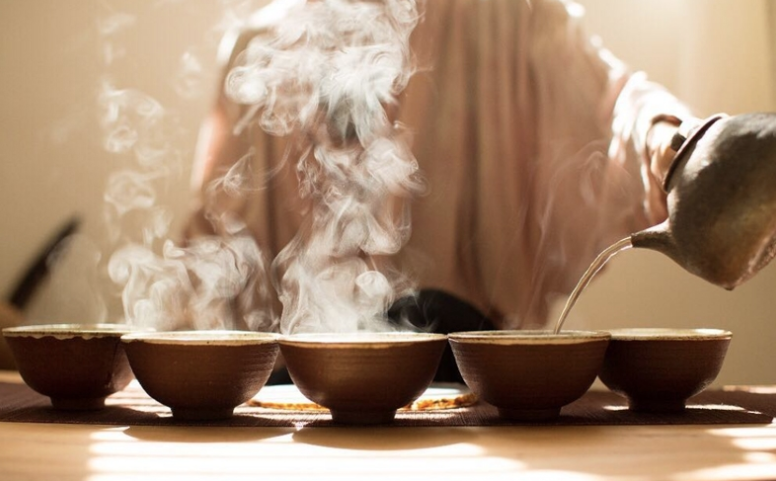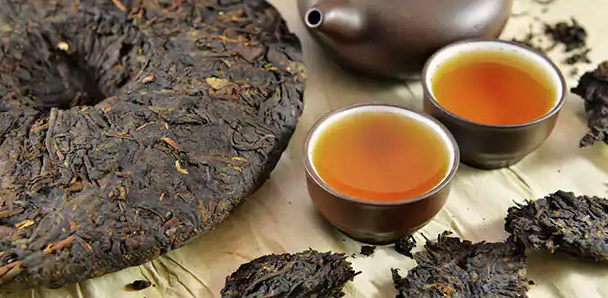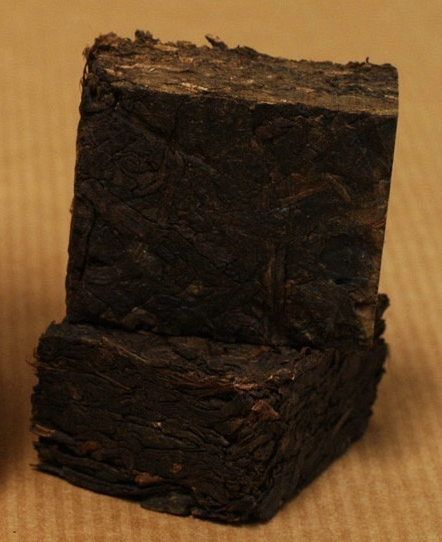Chinese tea has 5000 years of history, beginning in the Tang Dynasty, reaching its peak in the Song Dynasty when it was promoted across the world through the Silk Road. During the Ming Dynasty, the method of preparing tea changed from boiling tea to brewing tea.
Chinese tea is classified according to size of the tea plant - shrub or arbor, as well as according to the size of the leaves- big small and medium tea leaf. The size of the leaves determines the type of tea and hence the type of pot, brewing method and brewing time.

For example green tea uses the fresher tip of the tea leaves and require no boiling of the water to extract the beneficial properties of the tea. In green tea, there are antioxidants and tea polyphenols beneficial to health. For green tea a glass cup is used as it shows off the colour of the tea clearer and more beautifully. If you use leaf tips, do not brew more than 3 times as the ingredients will be released by then. White, oolong & puer tea requires a porcelain or ceramic teapot to brew. The tea is allowed to brew for longer to obtain extraction as the ingredients are released more slowly.
We have available a selection of visually stunning green tea flower balls here
Using the correct equipment for the type of tea, adds to the process of making tea. Originally from Jiangsu, Yixing Province, the Purple clay tea pot has special characteristics of breathability and is impermeable to the volatilisation of various ingredients. Traditionally porcelain tea cups with a white glaze is used to reflect the colour and aroma of the tea. Some more modern cups are made from wood and bamboo. However, if you would like to taste the tea without added aromas from these materials, use porcelain cups.

Here you can find purple clay sets:
Purple clay tea set 3 pcs
Purple clay tea set 7 pcs
Kungfu tea is tea drunk from a purple clay tea pot in a calm, happy , comfortable environment. The process of preparing the tea, calms you down to a slow pace to enjoy drinking the tea.
Traditionally, boiling water is not used for tea making. The tea master has a separate pot called the fair cup and the divider. Using the fair cup to let the boiling water cool down a bit before brewing the tea. After that, pouring water in tea divider when the temperature of tea is suitable for serving. It is a matter of personal preference how hot to drink the tea. Chinese tea cups have no handles because if it is too hot, you simply place it down, rather than hold it till it is cool.
A Gaiwan is a small vessel for brewing tea that takes the place of a teapot. Gaiwans have been used in China since the Ming Dynasty and typically consist of three parts: a bowl, lid, and saucer. It is typically small enough that all three parts can be picked up in one hand. Alternatively, the tea can be poured into the serving pitcher and then into the tasting cups.
You can find a Gaiwan here
Our extensive range of portable tea sets include a tea pot/cup, filter and case - a ceremony waiting to happen on the move! Find our other tea sets here
How To Use A Gaiwan
1. Prepare the tea leaves
Have them ready to be placed into the gaiwan as soon as it has been warmed.
2. Rinse the gaiwan
3. Rinse the gaiwan with hot water. This step signifies the purification of the gaiwan so that it is free of any dust or residue and also also warms the cup. If using a serving pitcher and tasting cups, pour the hot water from the gaiwan into these vessels and then discard the water.
4. Rinse the tea leaves
This opens up the leaves to release the aroma of the tea. Traditionally the aroma is savoured prior to brewing in order to prepare the palate to appreciate the full flavour. Add enough tea to fill about one-third of the gaiwan. With experimentation, the quantity can be adjusted to your taste. Pour hot water over the tea leaves and immediately pour this water off. Remove the lid and savour the aroma of the leaves.
5. Infuse and serve. Fill the gaiwan with water of the appropriate temperature. For green teas, steep uncovered for 30 - 45 seconds. For oolong and black teas, cover with the lid and steep about 45 seconds to 1 minute.
To drink from the gaiwan, hold the saucer in the palm of the right hand and use the thumb to steady the cup. Using your left hand, lift the lid by the knob, tilt the lid away so that it holds back the leaves and sip the tea. Alternatively, the tea can be poured into the serving pitcher and then into the tasting cups.
6. Re-steep
The benefit of using high quality, loose-leaf tea is that they can be re-steeped several times. Keep adding water as many times as it yields a flavourful cup. To re-steep, increase the steeping time about 15 seconds for each subsequent infusion. Experiment with steeping times to accommodate your taste. However, excessively long steeping can result in a bitter infusion. It is not recommended that tea leaves be left for a long period of time between infusions.

While it sounds easy, it will take you some practice to be able to perfect the tea pouring. There are a couple of obstacles. The tea may be too hot to handle. The tea lid may be slick and slide off too easily as you try to hold it to pour.
Our oldest aged Pu'er tea is produced in 1962, from leaves picked from ancient tea trees. This tea is 100% natural as no artificial additives are used in the production or storage. This specific Pu'er is a large leafed tea from the Yunnan province in China and has been famous as a medicinal tea. The earliest records of Pu'er tea date back to the Tang Dynasty (618AD - 906AD ) when it was the favourite tea of the nobleman of this time. Pu'er tea has been used over the centuries as a form of currency in China and was, and still is an important international trading item. You can find Puer tea here.
Make the time to enjoy our Pu'er tea, made with the tea set of your choice to access the timelessness of the traditional Chinese ceremony. Welcome to slow living!
References:
https://myteavault.com/how-to-choose-an-authentic-chinese-tea-cup/
https://www.rmg.co.uk/stories/topics/chinese-tea-ceremonies-traditions#:~:text=To%20hold%20a%20Chinese%20tea,brewing%20and%20drinking%20green%20tea
https://thefragrantleaf.com/pages/gaiwan-tea-preparation#:~:text=Fill%20the%20gaiwan%20with%20water,thumb%20to%20steady%20the%20cup.